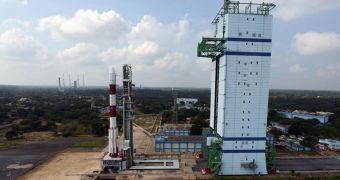The Mars Orbiter Mission (MOM), India's first foray into exploring the Red Planet, could spark a new space race, this time centered around Asian nations. The spacecraft is currently scheduled to take off tomorrow, November 5, from its launch pad at the Satish Dhawan Space Center, in Srihanikota.
MOM was developed by the Indian Space Research Organization (ISRO), and is meant to study the Martian atmosphere in great detail. It is one of two new orbiters to launch by the end of the year. Two weeks after it takes off, NASA will launch its Mars Atmosphere and Volatile EvolutioN (MAVEN) spacecraft, on November 18.
The Indian Launch Authorization Board greenlit the mission for launch on Tuesday, at 14:38 IST (09:08 UTC). The spacecraft will be delivered to Earth's orbit aboard a Polar Satellite Launch Vehicle (PSLV-C25), India's reliable, four-stage rocket.
All PSLV-C25/Mars Orbiter Mission rocket stages have been fueled, and nitrogen oxides and monomethylhydrazine have been mixed in. A completed dress rehearsal confirming that all systems are good to go occurred on October 31. The launch will be supported by two ISRO ships deployed in the Indian Ocean, which will ensure that all telemetry is relayed to ground stations.
The rocket will place MOM in an elliptical Earth orbit, measured at 248 by 23,500 kilometers (154 by 14,600 miles). The spacecraft will start its journey to Mars on or around December 1, following the completion of six orbital boost burns, Universe Today reports.
ISRO experts estimate that the trip will last for about 300 days. The orbital insertion burn will occur on September 21, 2014. If all goes well, MOM will be inserted into a highly-elliptical Martian orbit, measured at 366 by 80,000 kilometers (227.5 by 49,710 miles).
With MAVEN scheduled to enter orbit around Mars on September 22, 2014, the two orbiters are expected to work together on overlapping objectives, providing in-depth cover of the Martian atmosphere. Previous missions to the Red Planet, such as MRO and Mars Express, have largely focused on studying the planet's surface.
If MOM manages to enter orbit around Mars, India will become only the fourth nation to study our neighboring world with its own spacecraft, following on the heels of the United States, the Soviet Union, and the European Space Agency.

 14 DAY TRIAL //
14 DAY TRIAL //